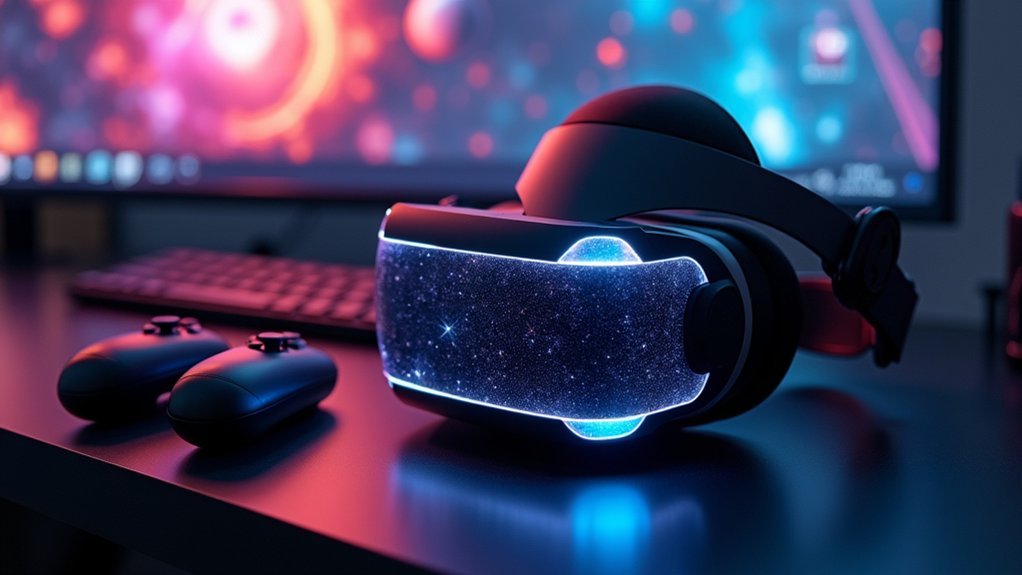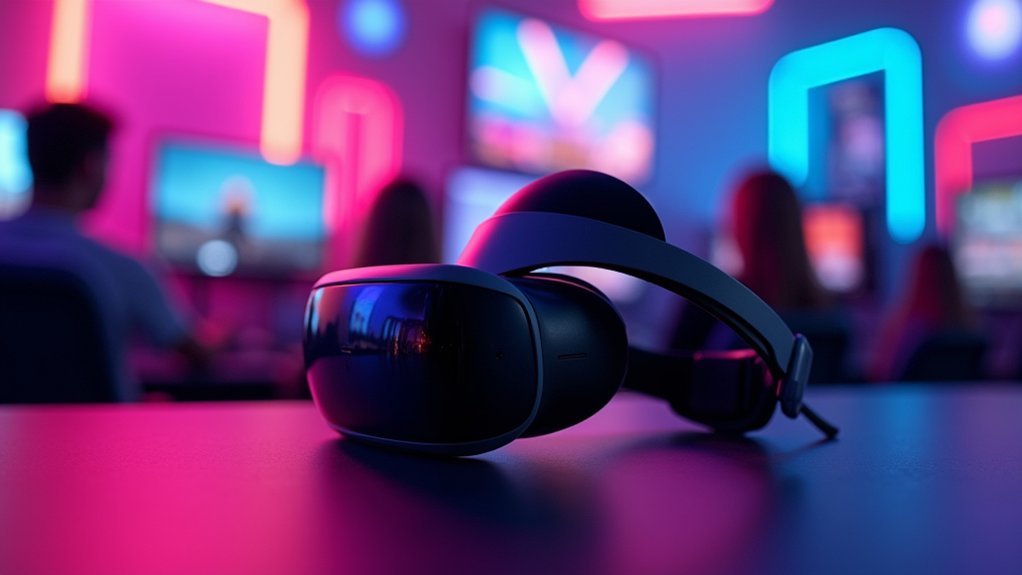You’ll find the Meta Quest 3 leads standalone VR with 2,064 x 2,208 pixel displays and mixed reality capabilities at $499.99, while the budget-friendly Quest 3S offers solid performance at $269.99. The Pimax Crystal Light delivers exceptional 2880 x 2880 resolution, and HTC’s VIVE XR Elite provides professional-grade tracking. Pico 4 Ultra weighs just 295 grams for extended comfort. Modern headsets overcome early limitations through improved processors, inside-out tracking, and play-while-charging features that’ll transform your gaming experience.
Meta Quest 3: Premium Standalone Performance

The Meta Quest 3 delivers exceptional standalone VR performance with its impressive 2,064 x 2,208 pixel-per-eye display that transforms your gaming experience through crystal-clear visuals.
Experience gaming like never before with the Meta Quest 3’s stunning 2,064 x 2,208 pixel-per-eye display delivering unmatched visual clarity.
You’ll enjoy seamless gameplay thanks to the powerful Qualcomm Snapdragon processor that eliminates lag and guarantees smooth performance across demanding titles.
What sets this standalone VR headset apart is its color pass-through cameras, enabling mixed reality experiences where you can interact with your physical environment while gaming.
The innovative pancake lenses and lightweight design maximize your comfort level during extended sessions, preventing fatigue that typically affects marathon gaming.
At $499.99, you’re investing in premium performance that doesn’t require additional hardware.
The Meta Quest 3 represents the pinnacle of standalone VR technology, combining cutting-edge features with practical design.
Meta Quest 3S: Budget-Friendly Entry Point
While premium features come at a premium price, Meta Quest 3S delivers impressive standalone VR headset performance at just $269.99, making it the most accessible entry point into wireless virtual reality gaming.
You’ll get solid performance from the Qualcomm Snapdragon XR2 Gen 2 processor, which handles Meta Quest games smoothly without compromising your budget-friendly investment.
The headset offers a decent visual experience with 1832 x 1920 resolution per eye, though it’s less sharp than pricier alternatives.
You’ll appreciate the simplified setup thanks to inside-out tracking technology that eliminates external sensors.
The inclusion of color pass-through cameras enables basic mixed reality interactions, enhancing your experience without requiring additional hardware.
For newcomers seeking affordable VR gaming, the Meta Quest 3S provides excellent value.
Pimax Crystal Light: High-Resolution Enthusiast Choice

For VR enthusiasts demanding crystal-clear visuals, Pimax Crystal Light delivers an exceptional 2880 x 2880 pixels per eye resolution that puts it among the sharpest standalone headsets available.
This high-resolution powerhouse runs on the Qualcomm Snapdragon XR2 Gen 2 processor, ensuring smooth performance across standalone games and PCVR applications.
You’ll appreciate the flexible tracking options, as this standalone VR headset supports both inside-out tracking and optional external sensors for enhanced accuracy.
The wide field of view markedly boosts immersion, making virtual environments feel more natural and expansive.
The expansive field of view creates remarkably immersive experiences, transforming virtual worlds into convincingly realistic environments.
However, you should consider the ergonomics carefully before purchasing.
While the Pimax Crystal Light excels in visual fidelity and performance, its fit can cause discomfort during extended gaming sessions, particularly affecting enthusiasts and professionals who require longer usage periods.
HTC VIVE XR Elite: Professional-Grade Standalone Experience
Targeting serious gamers and professionals who demand versatility, HTC VIVE XR Elite delivers a professional-grade standalone experience that seamlessly bridges entertainment and real-world applications.
You’ll appreciate its 1920 x 1920 pixels per eye resolution, creating sharp visuals for immersive experiences whether you’re gaming or conducting simulations.
The Qualcomm Snapdragon XR2 Gen 2 processor powers demanding VR applications without compromising performance.
You won’t need external sensors thanks to inside-out full-body tracking, which enhances your mobility and simplifies setup.
The lightweight design guarantees comfort during extended sessions, making it perfect for professional training scenarios.
This standalone headset excels in versatility, letting you switch between intense gaming sessions and productive professional applications.
You’re investing in a device that adapts to both entertainment and serious work requirements.
Pico 4 Ultra: Lightweight Comfort Champion

You’ll immediately notice the Pico 4 Ultra’s streamlined form factor that prioritizes portability without sacrificing visual quality, delivering crisp 2160 x 2160 resolution per eye.
The headset’s balanced weight distribution and ergonomic design let you game for hours without the neck strain that plagues heavier alternatives.
Under the hood, you’re getting Qualcomm’s Snapdragon XR2 Gen 2 processor paired with inside-out tracking that eliminates setup hassles while delivering smooth performance for both casual gaming and demanding applications.
Sleek Design Features
While many VR headsets sacrifice comfort for performance, the Pico 4 Ultra breaks this trend by delivering exceptional visual quality in a remarkably lightweight package.
You’ll immediately notice the sleek design that prioritizes both aesthetics and functionality. The lightweight design guarantees you can use for longer periods without experiencing the fatigue common with bulkier competitors.
The headset’s adjustable straps provide a customizable fit that accommodates various head shapes and sizes, eliminating pressure points during extended sessions.
You’ll appreciate how the compact form factor makes it incredibly portable, allowing you to transport it effortlessly between locations.
This thoughtful engineering creates an immersive experience where comfort never compromises performance, making the Pico 4 Ultra ideal for marathon gaming sessions.
Extended Wear Comfort
At just 295 grams, the Pico 4 Ultra stands as the lightweight comfort champion among standalone VR headsets, transforming how you experience extended gaming sessions.
Its lightweight structure eliminates the fatigue that typically plagues longer VR experiences, while the ergonomic design distributes weight evenly across your head.
The extended wear comfort comes from thoughtful engineering that minimizes pressure on your face and nose area.
You’ll appreciate the adjustable straps that accommodate different head sizes and the soft face cushion that maintains comfort throughout marathon gaming sessions.
When you’re exploring immersive environments, the user-friendly interface lets you make real-time adjustments without breaking immersion.
This combination of comfort-focused features guarantees you can dive deeper into virtual worlds without the physical limitations that plague heavier headsets.
Gaming Performance Specs
Behind the Pico 4 Ultra’s featherweight 300-gram frame lies serious gaming firepower that doesn’t compromise performance for portability. You’ll experience exceptional gaming performance through the Qualcomm Snapdragon XR2 Gen 2 processor, which handles demanding VR gaming applications with ease. The lightweight design guarantees user comfort during marathon sessions while delivering professional-grade specifications.
| Feature | Specification |
|---|---|
| Resolution | 2160 x 2160 per eye |
| Weight | 300 grams |
| Processor | Snapdragon XR2 Gen 2 |
| Tracking | Inside-out technology |
The Pico 4 Ultra’s inside-out tracking eliminates external sensor requirements, streamlining your setup process. You won’t need to sacrifice visual clarity for comfort—sharp 2160 x 2160 per-eye resolution maintains immersive detail. This combination of lightweight engineering and robust processing power makes extended gaming sessions effortless without performance trade-offs.
Sony PlayStation VR2: Console-Integrated Gaming
Sony’s PlayStation VR2 represents a considerable leap forward in console-based virtual reality gaming, exclusively designed for the PlayStation 5 to create a seamless integration with Sony’s gaming ecosystem.
You’ll experience immersive VR experiences through its sharp OLED display delivering 2000 x 2040 pixels per eye with vivid colors and enhanced visual fidelity.
The headset’s eye-tracking technology, haptic feedback, and adaptive triggers considerably boost user interaction compared to its predecessor.
You’ll appreciate the inside-out tracking capabilities that eliminate external sensors, making setup more accessible and user-friendly.
At $550, you’re getting high-quality performance with notable improvements over the original PlayStation VR, making it an excellent choice for console gamers seeking premium virtual reality experiences.
Meta Quest Pro: Advanced Tracking Technology
You’ll find the Meta Quest Pro’s eye-tracking technology transforms how you interact with virtual environments by enabling more intuitive navigation and precise gaze-based controls.
The headset’s face-tracking capabilities capture your facial expressions and translate them into your virtual avatar, creating more natural social interactions during meetings or gaming sessions.
With the Qualcomm Snapdragon XR2+ processor and 12GB of memory powering these advanced tracking features, you’ll experience smooth performance that keeps up with rapid eye movements and complex facial animations.
Eye-Tracking Technology Benefits
While traditional VR headsets rely on hand controllers and head movements for interaction, the Meta Quest Pro’s eye-tracking technology transforms how you’ll engage with virtual environments.
This standalone VR headset delivers enhanced user interaction by detecting where you’re looking, allowing you to select menu options and navigate interfaces with simple glances. The eye tracking enables foveated rendering, which reduces graphical processing in your peripheral vision while maintaining crisp detail where you focus, boosting performance considerably.
You’ll notice more realistic avatars in social VR spaces, as the system replicates your natural eye movements and expressions. This creates a truly immersive experience that feels more authentic.
Additionally, developers gain valuable user behavior insights from eye-tracking data, helping them craft more engaging and personalized virtual experiences.
Face-Tracking Capabilities Overview
Beyond eye tracking, the Meta Quest Pro’s face-tracking capabilities represent a breakthrough in social VR interaction.
You’ll experience unprecedented emotional expression as the headset captures your facial movements in real-time, transforming how others perceive you in virtual environments. The Qualcomm Snapdragon XR2+ processor handles complex facial recognition algorithms effortlessly, while 12GB of memory guarantees smooth performance during intensive tracking sessions.
This face tracking technology creates a personalized VR experience by adapting content based on your reactions and expressions.
Combined with eye tracking and foveated rendering, you’re getting immersive VR that responds naturally to your behavior. The Meta Quest Pro’s dual tracking system revolutionizes social gaming, making virtual conversations feel authentic and emotionally engaging for truly connected experiences.
Snapdragon XR2+ Performance
When the Qualcomm Snapdragon XR2+ processor takes control of the Meta Quest Pro’s operations, it delivers a 25% performance boost over its predecessor while consuming less power.
You’ll notice dramatically enhanced graphical capabilities that render complex virtual environments with stunning detail and fluid frame rates. This processing power eliminates the stuttering and lag that plagued earlier standalone headsets, creating truly immersive experiences.
The Snapdragon XR2+ works seamlessly with the Meta Quest Pro’s advanced tracking technology, including eye-tracking and face-tracking systems.
You can expect precise hand movements, accurate head positioning, and responsive gesture recognition that transforms your user experience. Whether you’re gaming for hours or conducting professional meetings, the improved performance guarantees smooth operation without overheating or battery drain issues.
Valve Index VR Kit: Superior Controller Design
The Valve Index VR Kit revolutionizes virtual reality interaction through its groundbreaking finger-tracking controllers that respond to individual finger movements with remarkable precision.
You’ll experience immersive gameplay that feels incredibly natural, thanks to pressure-sensitive grips that detect subtle hand movements and gestures. The controllers’ nuanced input capabilities allow you to interact with virtual objects in ways that weren’t possible before.
You’ll benefit from the headset’s high refresh rate of 120Hz, delivering smooth and responsive performance that eliminates motion blur.
The advanced tracking technology utilizes external lighthouse sensors for precise motion capture, ensuring accuracy even in large play areas. This superior controller design works seamlessly with countless VR titles on Steam, making the Valve Index your gateway to next-generation virtual reality experiences.
HTC Vive Pro 2: Maximum Visual Fidelity
You’ll experience unmatched visual clarity with the HTC Vive Pro 2’s ultra-high resolution display of 2,448 by 2,448 pixels per eye.
The headset’s premium graphics performance delivers smooth 120Hz refresh rates that eliminate motion blur during intense gaming sessions.
Whether you’re gaming or working with professional applications, you’ll benefit from the exceptional visual fidelity that sets this headset apart from competitors.
Ultra-High Resolution Display
Among standalone VR headsets, HTC’s Vive Pro 2 sets the gold standard for visual clarity with its remarkable 2,448 x 2,448 pixels per eye resolution.
This ultra-high resolution display delivers exceptional visual fidelity that transforms your gaming experience into something truly spectacular. You’ll notice crisp textures, sharp text, and detailed environments that eliminate the screen-door effect plaguing lower-resolution headsets.
The HTC Vive Pro 2 doesn’t stop at resolution alone. You’ll benefit from its impressive 120Hz high refresh rate, ensuring smooth motion without blurriness.
Combined with a wide field of view spanning 120 degrees, you’re fully immersed in virtual worlds. Steam VR compatibility grants access to countless games optimized for this premium display technology, making professional applications and high-end gaming equally compelling.
Premium Graphics Performance
Beyond stunning display quality, graphics performance becomes the critical factor determining how well you’ll experience those crisp visuals. The HTC Vive Pro 2 delivers premium graphics performance through its advanced graphical capabilities, requiring high-end gaming PCs to access maximum potential.
You’ll notice remarkable visual clarity during demanding VR applications, from intense gaming sessions to professional simulations.
The headset’s superior motion tracking system uses external base stations to capture precise movements, creating a truly immersive experience. With its 120Hz refresh rate reducing motion blur, you’ll enjoy smoother gameplay that complements the exceptional graphics.
This combination makes the Vive Pro 2 ideal for serious gamers and professionals who demand top-tier performance. The result is uncompromising visual fidelity that transforms how you interact with virtual environments.
Professional Application Support
While gaming showcases the HTC Vive Pro 2’s impressive capabilities, professional applications truly demonstrate why this headset stands apart in the VR landscape.
This standalone VR headset delivers exceptional visual fidelity through its 2,448 by 2,448 pixel resolution per eye, making it indispensable for demanding professional applications.
The Vive Pro 2’s advanced graphical capabilities support critical industry workflows:
- Design visualization – Architects can explore detailed 3D models with precise motion tracking
- Training simulations – Companies leverage spatial audio support for realistic scenarios
- Content creation – VR content creators benefit from 120Hz refresh rates for smooth production workflows
- Engineering analysis – Technical professionals utilize maximum visual clarity for complex data visualization
You’ll find the headset’s professional software compatibility enables seamless integration into existing workflows across design, simulation, and training environments.
Battery Life Challenges and Solutions
One of standalone VR’s most persistent hurdles remains battery life, with popular headsets like the Meta Quest 3 delivering roughly two hours of gaming before requiring a recharge.
High-resolution settings and demanding applications drain power faster, making battery monitoring essential during intense sessions.
Fortunately, you’ve got several solutions. The Meta Quest 3 supports play-while-charging, letting you continue gaming with a charging option connected.
For extended sessions, manufacturers recommend using a high-capacity external battery pack that greatly extends playtime beyond built-in limitations.
Software optimization also plays an important role. Developers increasingly focus on managing power consumption through performance settings, helping mitigate these challenges.
As standalone VR devices evolve, improved battery technology and smarter power management continue addressing this fundamental limitation, making longer gaming sessions more achievable.
Frequently Asked Questions
What Is the Most Powerful Standalone VR Headset?
You’ll find the Meta Quest 3 is the most powerful standalone VR headset. It’s equipped with Snapdragon XR2 Gen 2 processor, 2064×2208 resolution per eye, and 120Hz refresh rate for exceptional performance.
What Is the Best VR Headset That Doesn’t Need a PC?
You’ll want the Meta Quest 3 for the best standalone VR experience without a PC. It delivers exceptional 2,064 by 2,208 pixel resolution per eye and powerful processing in a completely self-contained headset.
How Can VR Be Used Outside of Gaming?
You can use VR for immersive education, professional training simulations, virtual workplace collaboration, interactive fitness workouts, and therapeutic treatments like exposure therapy for phobias and PTSD in controlled environments.
Is Standalone VR Better Than PC VR?
You’ll find standalone VR offers convenience and portability, while PC VR delivers superior graphics and performance. Your choice depends on whether you prioritize ease-of-use or cutting-edge visual quality and processing power.





Leave a Reply